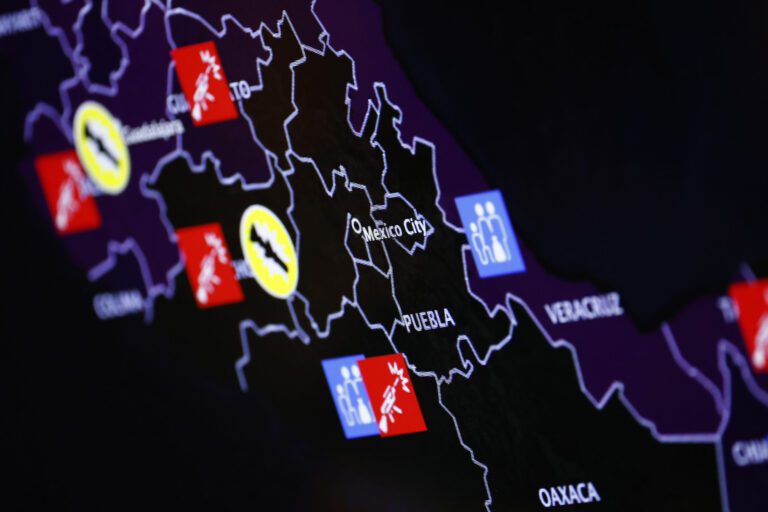Escalating Cartel Violence in Mexico: A Deepening Crisis
The violence fueled by drug cartels in Mexico has reached alarming heights, especially evident in disturbing incidents like the gruesome discovery of two mutilated bodies hanging from an overpass in Ciudad Juárez on June 13. Labeled as “crystal dealers” accused of stealing fuel, this shocking incident was part of a deadly night that saw seven fatalities, highlighting the ongoing cartel wars despite intensified crackdowns from the U.S. and Mexican governments.
Increasing Violence in Key Regions
As stated by retired DEA assistant special agent Wesley Tabor, regions such as Juárez, Guanajuato, and Tamaulipas are witnessing a pronounced escalation in violence during 2025.
- Guanajuato: This area remains a battleground for the Jalisco New Generation Cartel (CJNG), which is not only clashing with rival groups but also targeting municipal governments and police forces.
- Tamaulipas: Coalition remnants from the Gulf Cartel engage in paramilitary-style ambushes and coordinated blockades, contributing to the ongoing chaos.
As cross-border drug smuggling becomes increasingly difficult due to U.S. interdictions, cartels are shifting tactics, more aggressively resorting to kidnappings for ransom and forced labor, with migrants being primary targets.
U.S. Government Actions Against Cartels
In response to the escalating violence, the Trump administration has launched a robust crack down on Mexican cartels, categorizing them not merely as criminal organizations but also as foreign terrorist entities. This classification facilitates the use of:
- Asset Freezes
- Travel Bans
- Enhanced Surveillance
Attorney General Bondi remarked that recent Supreme Court decisions supporting the president’s executive orders will bolster efforts against cartel activities.
“Increasing technology and intelligence-sharing with Mexican counterparts are integral to dismantling trafficking networks,” Tabor notes, further acknowledging the necessity for U.S. agencies like the Drug Enforcement Administration (DEA) to bolster funding to combat cartel leadership.
Cartels Adaptive Strategies
As the pressure mounts, cartels have shown a remarkable ability to adapt.
- Diversification of Criminal Activities: Gang involvement has expanded, increasing incidents of kidnapping and extortion.
- Innovation in Operations: Use of advanced technologies such as drones and social media for propaganda has become commonplace.
Criminal Networks and New Challenges
Cartels are evolving beyond traditional drug trafficking; they are now engaging in various crimes including:
- Human Trafficking
- Oil Theft
- Kidnappings
Andrew Lewis, head of The Ulysses Group, notes that cartels are diversifying in response to increased U.S. enforcement, evidenced by:
- Use of Crypto Laundering
- Decentralized Command Structures
Ongoing Violence and Its Toll
The violence comes with significant humanitarian costs. A recent discovery of 60 bodies, including over ten infants and women, in a mass grave highlights the tragic loss of life amidst the cartel wars. The violent landscape has led to over 480,000 killings since 2006, with 30 individuals reported missing daily.
Furthermore, as noted by experts, the current security crisis is escalating, with 3,000 homicides recorded in Guanajuato alone in 2024, showcasing a dire need for comprehensive reforms.
Technological Responses and Challenges
As cartels heighten their operational capabilities, the U.S. and Mexican governments are ramping up their technological responses. Key strategies include:
- Increased Border Surveillance: Drones and satellites are now being utilized in cartel-heavy areas.
- Targeting Financial Institutions: The U.S. has prohibited transactions with three Mexican banks suspected of laundering drug money.
Recent Sanctions and Targeted Operations
Recently, sanctions against cartel leaders have intensified, affecting prominent figures within the CJNG and the Sinaloa cartel. Following the Fentanyl Sanctions Act, the U.S. has targeted financial institutions, significantly limiting cartel operations.
The Future of Counter-Cartel Efforts
While U.S. crackdown efforts are underway, experts suggest the need for refining tactics to address the evolving challenges presented by cartels.
- Enhanced Intelligence Operations: Embedding U.S. agents within Mexican task forces may better target critical locations like fentanyl labs and high-kidnapping corridors.
- Maritime Surveillance: There’s a pressing need for increased monitoring in the Gulf Coast and Caribbean, where traffickers are shifting their routes.
Experts’ Insights on Future Strategies
“It’s no longer just a drug war but a hybrid criminal insurgency that needs urgent attention,” warns Tabor. The ongoing situation calls for extensive cooperation between governments to address deeply entrenched issues within Mexican institutions.
The ongoing escalations showcase that while the U.S. can provide support through sanctions and intelligence, the cornerstone of effective action lies with comprehensive reform and resolve from within Mexico itself.
Conclusion: Navigating the Complex Landscape
As cartel violence continues to plague Mexico, a multifaceted approach that includes enhanced cooperation, targeted sanctions, and strategic monitoring seems crucial. The window for effective intervention is closing, prompting the need for urgent action on both sides of the border.
For further information, refer to resources on cartel violence and U.S. counter-narcotic strategies here and delve deeper into the transformation of drug trafficking networks in the contemporary landscape here.
Related Links
By maintaining awareness of developments in this ongoing crisis, we can better understand the implications of cartel activities on both Mexican and U.S. territories.


